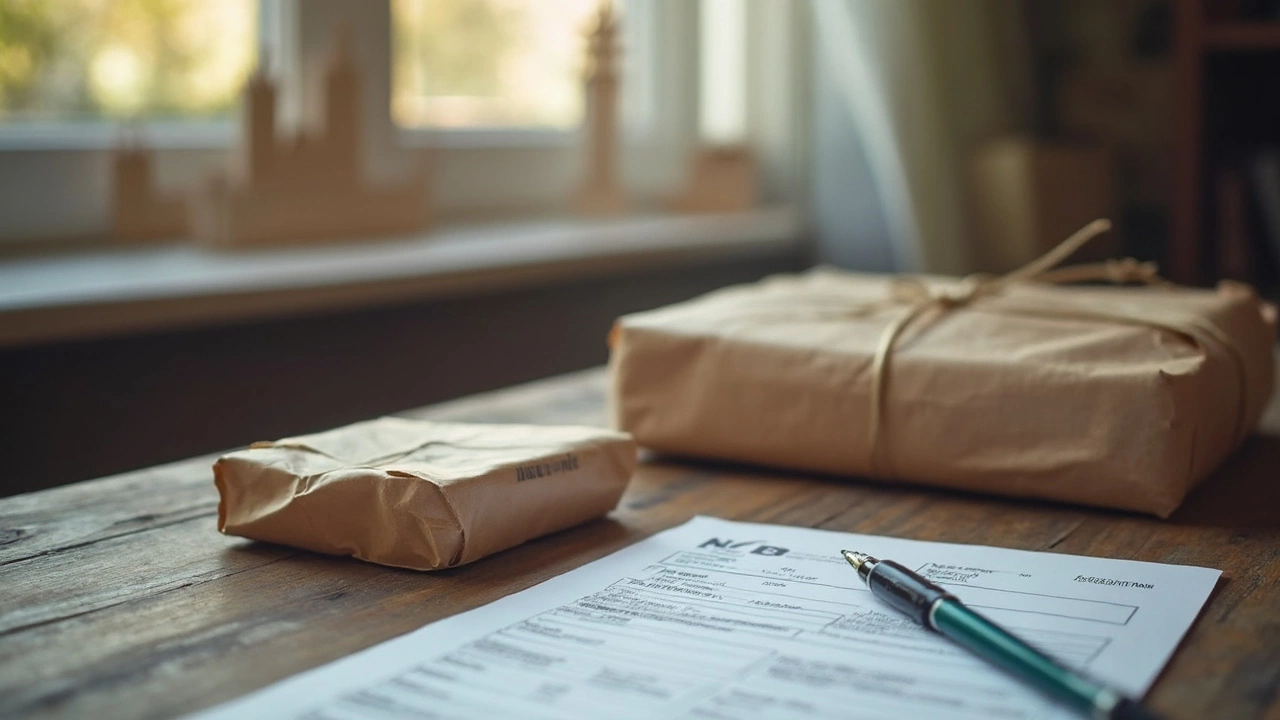Surprisingly, not every USPS package comes with delivery insurance. You might assume every box or padded envelope gets covered just for being handed over the counter, but it’s not that simple. USPS does offer insurance, but the details depend a lot on the shipping service you choose—and how much you actually declare that your stuff is worth.
If you’re mailing something important—think a laptop, collectible, or grandma’s surprise birthday gift—you need to pay extra attention. USPS does include free insurance with some services, like Priority Mail and Priority Mail Express, but that coverage only goes so far. Drop a regular First-Class stamp on a package, and you’re on your own if it gets lost or crushed.
Before sending anything valuable, it’s smart to check what’s actually covered and decide if you need to buy extra insurance. Trust me, a few bucks at the post office can save a ton of headache if something bad happens in transit. Whether you ship a lot or just once in a blue moon, knowing how USPS insurance actually works can save time, money, and a lot of stress.
- Do USPS Packages Come With Insurance?
- Which USPS Services Include Free Insurance?
- When Should You Buy Extra Insurance?
- How to File a USPS Insurance Claim
- Tips for Avoiding Delivery Headaches
- Is USPS Insurance Worth It?
Do USPS Packages Come With Insurance?
Here’s the straight answer: not every USPS package is automatically covered. Whether your shipment has any built-in protection depends on the service chosen at the counter or online. If you pay for Priority Mail or Priority Mail Express, you get a layer of insurance, no extra steps required. Other methods, like First-Class Package Service or Retail Ground, leave you unprotected unless you add it yourself.
Here’s a quick breakdown to help clear the confusion:
- USPS Priority Mail includes up to $100 of insurance for free, so if your box is lost or damaged, you could file a claim up to that amount.
- Priority Mail Express usually covers up to $100, too—sometimes higher if you pay for more coverage.
- First-Class mail (letters, postcards, and small parcels) comes with zero insurance. If you want protection, you have to pay extra.
- USPS Retail Ground and Media Mail also do not come with automatic insurance.
- International shipments work differently; coverage, if any, depends on the destination and service level.
If you’re unsure, here’s a simple comparison table:
| USPS Service | Free Insurance Included? | Coverage Amount |
|---|---|---|
| Priority Mail | Yes | Up to $100 |
| Priority Mail Express | Yes | Up to $100 (can add more) |
| First-Class Package | No | None |
| Retail Ground | No | None |
| Media Mail | No | None |
Keep in mind, if you’re sending something worth more than the basic coverage—or want any coverage at all with services that don’t include it—you’ll need to buy additional insurance when you ship your package. Keep your receipts. USPS will ask for proof if you ever have to file a claim. And if you reuse packaging, like an old Priority Mail box for a Retail Ground shipment, you won’t get the insurance just because of the box. What matters is what you actually pay for, not the cardboard itself.
Which USPS Services Include Free Insurance?
If you’re sending a package and hoping for some built-in coverage, here’s where things get interesting. Not every USPS service automatically covers your stuff for loss or damage. A few do, though—and knowing which ones can actually save you money if you pick your shipping method smartly.
The two main USPS options that include free insurance are Priority Mail and Priority Mail Express. Here’s how it works:
- Priority Mail: This service comes with up to $100 of insurance at no extra cost. That’s for most domestic packages, but sometimes it’s capped at $50 for some retail customers or certain shipments. Commercial senders can also get different limits, so always check the fine print at the counter or online.
- Priority Mail Express: The fastest USPS option gives you up to $100 of free coverage for both domestic and international packages. If something goes missing or gets wrecked during shipping, you can file a claim right away—no extra charge for the protection.
The only other built-in options come with specific high-end services:
- USPS Retail Ground, First-Class Package Service, and Media Mail: These do not come with automatic insurance. If you want coverage, you’ll have to pay for it separately at the post office counter or online.
Here’s a simple table to keep it straight:
| USPS Service | Free Insurance? | Coverage Amount |
|---|---|---|
| Priority Mail | Yes | Up to $100 ($50 for some shipments) |
| Priority Mail Express | Yes | Up to $100 |
| First-Class Package Service | No | N/A |
| USPS Retail Ground | No | N/A |
| Media Mail | No | N/A |
One last tip: Insurance covers the value of the contents, not sentimental worth, so always keep your receipts. And if you’re counting on that USPS protection, check the rules for what’s covered and be ready to buy extra insurance if what you’re sending is really pricey.
When Should You Buy Extra Insurance?
Here’s the straight talk: you don’t need to buy extra insurance for every single package. But there are certain situations where it’s honestly a no-brainer. USPS Priority Mail and Priority Mail Express toss in some free coverage, but usually only up to $100 or $200. If your stuff is worth more than that, it’s time to consider extra protection.
Think about these common scenarios:
- High-value items: Phones, jewelry, designer clothes, vintage collectibles, electronics—if it would seriously sting to lose it, add more insurance.
- Online sales: If you’re selling on eBay, Poshmark, or Etsy, buyers expect their orders to arrive safely. Extra insurance covers both you and your customer if something goes sideways.
- Fragile or irreplaceable packages: If the item would cost a lot to repair, or it’s unique (like artwork or custom items), more coverage gives peace of mind.
- Business shipments: Companies sending equipment, products, or important documents should never skimp on insurance. The cost of a lost or damaged package can easily dwarf the price of added coverage.
Here’s a super quick cheat sheet for USPS insurance coverage:
| Service | Default Insurance | Max You Can Buy |
|---|---|---|
| Priority Mail | Up to $100 | Up to $5,000 |
| Priority Mail Express | Up to $100 | Up to $5,000 |
| First-Class Package | None | Up to $5,000 (added by request) |
| Retail Ground | None | Up to $5,000 (added by request) |
One more thing—don’t pad the value just to get more from a claim. USPS will want receipts or proof if you file, so only insure the actual value. And if your package is leaving the U.S., know that international insurance rules are a lot stricter, and coverage might not always be available for every country or service.
If you’re unsure, ask the clerk at the counter or check the USPS website, but generally, if your package’s value is higher than the included insurance, just get the extra coverage. For a few extra dollars, it can save you a world of regret if something happens.

How to File a USPS Insurance Claim
If your package gets lost or arrives damaged, filing a USPS insurance claim is actually pretty straightforward, but you have to follow a few important steps. First, grab your tracking number and proof of value (like a receipt or invoice)—USPS won’t even look at your claim without these.
You need to start your claim online at the USPS website.* Claims for lost items can be filed after seven days from the mailing date and up to 60 days (keep those timeframes in mind!). Damaged packages also fall inside that 60-day window. Pretty much all claims are digital now, so don’t bother running to your local post office unless they specifically tell you to.
- Go to the official USPS Claims page and log in (or create) a free account.
- Enter your tracking number, proof of insurance, and upload your documents—this includes your original sales receipt, and if possible, photos of damage or the contents if they’re missing.
- Fill out all required fields about the mailing details, what went wrong, and your loss amount. Keep it simple and honest.
- Submit your claim. You’ll get a confirmation email from USPS with a claim number so you can track progress.
- If USPS needs more information, respond to their emails quickly—this can make or break how fast you get paid back.
Wondering how long it takes? Claims usually get reviewed in 5-10 business days, though sometimes it drags out if USPS needs to “investigate” further. If your USPS insurance claim is approved, the payment comes by check or direct deposit. And here’s a tip: double-check your claim documents—missing one tiny detail can freeze the whole process.
| Claim Type | Earliest Filing Day | Latest Filing Day |
|---|---|---|
| Lost mail | 7 days | 60 days |
| Damaged item | Day after delivery | 60 days |
| Missing contents | Day after delivery | 60 days |
Save every scrap—a torn box, photo of the damage, emails with buyers—because USPS can ask for proof at any point. The stricter you are with your records, the less pain you’ll feel if you need to make a claim. Don’t toss receipts until you know your package made it safe and sound.
Tips for Avoiding Delivery Headaches
No one loves getting that “your package couldn’t be delivered” message, or worse, realizing a box showed up battered—or never arrived at all. Want to avoid these delivery nightmares? There’s a few simple things you can do before handing over your package at the post office.
- USPS always recommends double-checking the recipient’s address. One tiny typo and your box could end up in the wrong city. Print the label or use a clear marker, and if you’re handwriting it, legibility matters.
- Packaging is huge. Don’t just reuse any old box—pick something sturdy. USPS even gives out free Priority Mail boxes. Bubble wrap fragile items and fill any empty space with packing peanuts, paper, or whatever you have handy, so stuff doesn’t rattle around.
- Add a return address. This gives your package a second chance if delivery fails. It’s an easy fix that a crazy amount of people skip.
- If it’s valuable, get a tracking number. First-Class packages don’t have tracking by default, but Priority Mail and up do. Scan the receipt into your phone so you never lose it.
- Don’t forget about weather. If it’s blazing hot or freezing, let your recipient know when to expect the box so nothing melts, spoils, or gets ruined sitting outside.
- Ship early, especially during holidays. The closer you ship to big dates, the higher the odds your stuff gets stuck in a pile of delayed packages.
If you’re unsure which insurance or tracking level you need, check out this quick breakdown:
| USPS Service | Includes Tracking? | Free Insurance | Can Buy Extra Insurance? |
|---|---|---|---|
| Priority Mail | Yes | Up to $100 | Yes (up to $5,000) |
| Priority Mail Express | Yes | Up to $100 | Yes (up to $5,000) |
| First-Class Package | Yes | No | Yes |
| Media Mail | Yes | No | Yes |
A few extra minutes at the counter can save days of frustration if something goes wrong. And if you need proof of delivery—like for selling online—get a signature confirmation. For really pricy shipments, consider Registered Mail, which is handled under lock and key each step of the way. It costs more, but the peace of mind is real.
Packages can go missing, but basic prep cuts the risk way down. Cover the details, choose the right service, and you’ll make delivery headaches a thing of the past.
Is USPS Insurance Worth It?
If you’re wondering whether to spend a few extra bucks on USPS insurance, you’re not alone. The real answer comes down to how much your package is worth and what kind of risk you can stomach. Some people roll the dice, but if you’re sending something valuable or one-of-a-kind, insurance can be a lifesaver.
Here’s a quick rundown: USPS automatically includes some insurance with services like Priority Mail and Priority Mail Express. For Priority Mail, you get up to $100 coverage. Priority Mail Express gives you $100 too. But regular First-Class Mail? Zero free insurance. So for those cheap options, you’ll have to add coverage yourself if you want it.
How often do things actually go missing? According to the USPS 2024 Annual Report, fewer than 1 in every 20,000 Priority Mail packages are reported lost or damaged. That’s a tiny percentage, but when it happens to you, it feels like 100%. If you’re shipping rare baseball cards, specialty electronics, or handmade art, it only takes one disaster to wish you’d played it safe.
- If the item’s value is under $50 and you can live with replacing it, skip the insurance.
- For anything irreplaceable or over $100, pay for extra coverage—especially for eBay or Etsy sales where buyers expect you to make things right.
- Always save your proof of value and shipping receipt. USPS will ask for these if you file a claim.
Here’s a side-by-side look at what different USPS insurance options actually cost and cover:
| USPS Service | Included Insurance | Extra Insurance Cost (approx.) |
|---|---|---|
| Priority Mail | $100 | $2.70 per $100 extra coverage |
| Priority Mail Express | $100 | $2.70 per $100 extra coverage |
| First-Class Package | None | $2.70 per $100 coverage |
| Retail Ground | None | $2.70 per $100 coverage |
So, is USPS delivery insurance worth it? It almost always makes sense for high-value stuff, holiday gifts, and anything you’d hate to lose. For boring or cheap mail, you can skip it and save a little cash. But when in doubt, insurance is a small price to pay for peace of mind.





